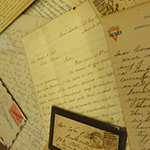 University Library
Sources of Inquiry
University Library
Sources of Inquiry
 University Library
Sources of Inquiry
University Library
Sources of Inquiry
Creative works are those that feature artistic expression, whether visual, literary, or performance based. People express themselves creatively for a number of reasons. Some wish to communicate ideas or emotions, to make a statement or express opinions, or to give form to the immaterial. By studying and analyzing creative works, we can add depth and dimension to our understanding of the lives of individuals who created or enjoyed them, and the time and place in which they lived.
On display in the case are creative works that highlight important political and social issues, or capture significant historical events. The Wounded Scout: A Friend in the Swamp, depicts a Civil War Union soldier assisted by an escaped slave. It addresses important questions about race during the war, and the heated discussion about freed slaves that ensued during the Reconstruction Era. An anti-semitic World War II-era political cartoon characterizes a Judaized Hollywood pouring money into the pocket of a refugee while a native-born American is forced on the dole. Several examples of literature, lyrics, and music serve to document traditions, cultures, and the evolution of beliefs and customs over time.
In some instances, evidence of creative works may be all we have to document the ephemeral art experience, and the context in which it occurred. Although Bebop Records closed nearly three decades ago, an open reading sign-up sheet documents the venue's history as an alternative performance space for local musicians, poets, and visual artists. The poster on the wall advertises a program of music and entertainment held at the Palais du Trocadéro in Paris, France. It featured 200 child artists and benefitted Belgian refugees who escaped to England during World War I.
You've reached the end of the audio tour for the Sources of Inquiry Exhibit. Thanks for listening! We hope you've enjoyed spending time here today.
1
Rogers, John. The Wounded Scout: A Friend in the Swamp, plaster reproduction, 1864.E 608 R64 1864
2
World War II-era political cartoon "Sitting Pretty," 1942Reverend Wendell L. Miller Collection
3
Anti-semitic cartoon, 1941Jewish Federation Council of Greater Los Angeles, Community Relations Committee Collection, Part 2
4
Open reading sign-up sheet from Bebop Records, October 21, 1987Richard Bruland Bebop Records Art Posters Collection
5
Bawdy World War II-era song of unknown origin, circa 1941World War II Joke and Humor Collection
6
Saunders, Nathaniel. The Temperance Songster. Providence: Handy & Higgins, 1867.HV 5070 S3
7
Armenian Popular Songs, translated into English by Leo Alishan. Venice: S. Lazarus, 1852.PK 8535 A6 1852
8
Shakespeare, William. Shakespeare's Plays: 4th Folio, London: H. Herringman, E. Brewster, and R. Bentley, 1685.PR 2751 A4
9
Bartlett, Truman Howe. Walt Whitman's Hand, cast bronze, April 17, 1881.PS 3231 B295 1881
10
Poster for show at the Palais du Trocadéro, March 30, 1916Theatrical Promotion Collection
